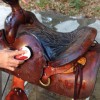 The South’s climate is appealing for equestrian activities. While riders enjoy the weather, it creates some challenges in caring for saddles and other tack. When the weather becomes hot and the humidity climbs and the rains are frequent, a tack room can become a breeding ground for mold and mildew. There are several things a rider can do, however, to lower the incidence of mildew on saddles and tack. This 3-page fact sheet was written by Joel McQuagge, Todd Thrift, and Ed Johnson, and published by the UF Department of Animal Sciences, November 2014. (Photo credit: Joel McQuagge, UF/IFAS)
The South’s climate is appealing for equestrian activities. While riders enjoy the weather, it creates some challenges in caring for saddles and other tack. When the weather becomes hot and the humidity climbs and the rains are frequent, a tack room can become a breeding ground for mold and mildew. There are several things a rider can do, however, to lower the incidence of mildew on saddles and tack. This 3-page fact sheet was written by Joel McQuagge, Todd Thrift, and Ed Johnson, and published by the UF Department of Animal Sciences, November 2014. (Photo credit: Joel McQuagge, UF/IFAS)
http://edis.ifas.ufl.edu/an303
Tag: Edward L. Johnson
4-H Horse and Pony Lease (4HHSF01/4H318)
In the Florida 4-H Horse Lease Program, the same animal may be leased by up to three 4-H members and all Lessees must conform to the requirements of the Florida 4-H Equine Program. This revised 7-page publication contains the forms that might be needed for one 4-H’er to lease a horse: a page of instructions, a page of advice, the 3-page lease form, and 2 copies of the addendum (if up to two others are sharing Horse). Written by E.L. Johnson and Wendy DeVito, and published by the UF Department of 4-H Youth Development, March 2011.
http://edis.ifas.ufl.edu/4h318
Fundamentals of Bit Selection and Use (AN256)
Choosing an appropriate bit can be a confusing process for horse enthusiasts. This 6-page illustrated fact sheet describes the various types of bits and how to select the best bit for horse and rider. Written by Edward L. Johnson and Kylee J. Duberstein. Published by the UF Department of Animal Sciences, January 2011.
http://edis.ifas.ufl.edu/an256
Caring for the Older Horse: Common Problems and Solutions (AN253/AN253)
Horses often live into their late 20s and early 30s. But as the horse ages, its needs change, and additional care may be required to keep it as healthy as possible. This 5-page fact sheet addresses changes in the aging horse’s body that impact its requirements, along with possible ways to meet these requirements and solutions to problems that may occur. It was written by Edward L. Johnson, Kylee Jo Duberstein and Mark Shuffitt, and published by the UF Department of Animal Sciences, October 2010.
http://edis.ifas.ufl.edu/an253
SSAGR65/AA216 Pastures and Forage Crops for Horses
Revised! SS-AGR-65, an 8-page fact sheet by Y. C. Newman, E. L. Johnson, J. Vendramini, C. Chambliss, and I. V. Ezenwa, discusses site selection, stocking rate, varieties, and pasture management for horses. Published by the UF Department of Agronomy, September 2010.
http://edis.ifas.ufl.edu/aa216
AN235 Basic Nutritional Guidelines for Equine Management
AN235, a 4-page fact sheet by Edward L. Johnson and Kylee J. Duberstein, lists 25 key points to keep in mind when determining how to meet one’s horse’s nutritional requirements. Published by the UF Department of Animal Science, March 2010.
http://edis.ifas.ufl.edu/an235
AN236 How to Feed a Horse: Understanding Basic Principles of Horse Nutrition
AN236, a 5-page fact sheet by Edward L. Johnson and Kylee J. Duberstein, discusses the nutritional needs of horses, common guidelines to observe when feeding one’s horse, and how to determine if a horse’s nutritional requirements are being met. Published by the UF Department of Animal Science, March 2010.
http://edis.ifas.ufl.edu/an236